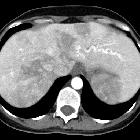Angiodysplasien des Gastrointestinaltraktes


Gastrointestinal angiodysplasias or angioectasias are one of the most common causes of occult gastrointestinal bleeding.
Epidemiology
Peak incidence occurs in patients in their 60-70s .
Clinical presentation
Patients can present with symptoms and signs upper or lower gastrointestinal bleeding although they can commonly be an incidental finding.
Pathology
Angiodysplasia refers to dilated, thin-walled blood vessels (capillaries, venules, veins) found in the mucosa and submucosa of the gastrointestinal tract. The pathogenesis is unclear . They are multiple in ~50% of cases , and can be found throughout the gastrointestinal tract, but most commonly in the cecum and right colon on the antimesenteric border.
Associations
- Heyde syndrome: bleeding angiodysplasia and aortic stenosis (controversial )
- chronic renal failure
- von Willebrand disease
Radiographic features
CT
- appear as focal areas (< 5 mm) of contrast enhancement in the bowel wall (most prominent in the enteric phase )
- early filling of an antimesenteric vein
Angiography
- ectatic vessels but no mass
- early venous enhancement indicating arteriovenous shunting
Treatment and prognosis
Approximately 50% of gastrointestinal hemorrhage from angiodysplasia ceases without intervention. Endovascular treatment is generally not effective and first-line treatment is interventional endoscopy. There is a post-treatment bleeding rate of ~25% .
Siehe auch:

 Assoziationen und Differentialdiagnosen zu Angiodysplasien des Gastrointestinaltraktes:
Assoziationen und Differentialdiagnosen zu Angiodysplasien des Gastrointestinaltraktes:
